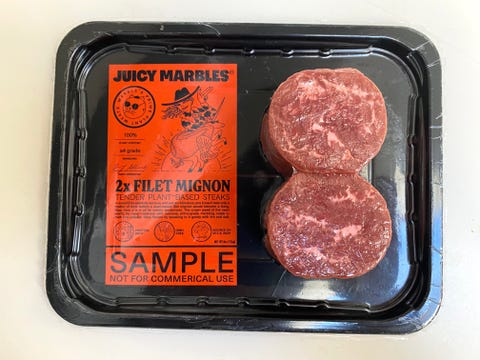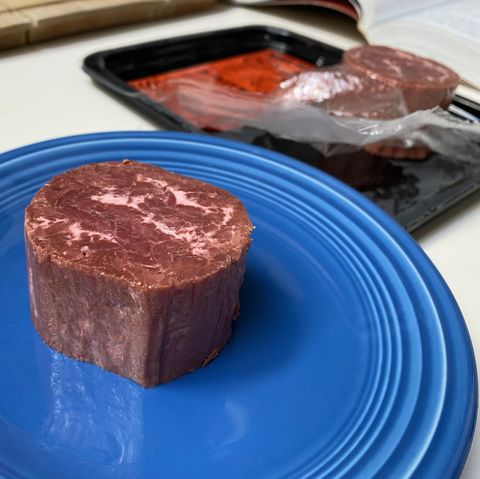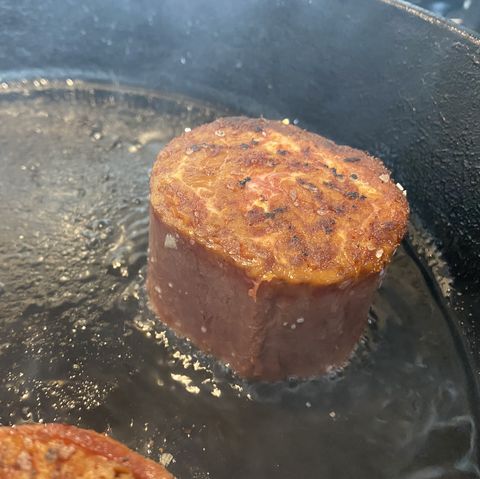WE ARE now inundated with fake meat.
In the 11 years since Beyond Meat first launched, followed two years later by Impossible Foods, plant-based meat products have grown from a once side-eyed science experiment to a totally acceptable and still-kind-of-cool thing you’d pick up for a backyard cookout.
There are now Impossible Whoppers at Burger King and Beyond nuggets at KFC. There are plant-based sausage patties for your breakfast sandwiches and pebbled pea-protein crumble for your burrito bowls.
And now, as the fake meat industry stretches into its second decade as A Thing, there’s a glut of plant-based products on the market.
While the early stages of the pandemic saw a sales uptick in meat amalgams at American grocery stores, they’ve since dropped off. Sales of plant-based fast food items never really took off—and some of them ghosted menus altogether. Beyond Meat stock is flat compared to its IPO in 2019 and Impossible Foods has toyed with the idea of going public but … Beyond Meat.
Call it “fauxtein fatigue” or “meatless malaise” or “plant-based growing pains,” but the entire food category seems in need of a shake up—like the once rager of a plant-based party has gone on later and longer than it ever should have.
But now and interesting twist: Juicy Marbles has arrived.
Yes, the company’s name is Juicy Marbles.
Juicy Marbles makes, of all things, a plant-based filet mignon steak so tender, so flavorful, and so similar in appearance and texture that you’ll fool yourself into eating a high-end cut for a whole lost less money than the real thing. At least this is what the company argues.
We at Men’s Health have been covering plant-based protein from a health and nutrition perspective since its early-ish days. So when the opportunity to taste test a Juicy Marbles filet mignon came across my inbox, I accepted the invitation with an open and curious mind.
What ingredients make up a Juicy Marbles filet mignon? What’s the nutrition in a serving and how does that compare to beef filet mignon? Is this stuff healthy? What does it taste like?
And, perhaps most importantly of all, what the hell is a Juicy Mables?
What the hell is a Juicy Marbles?
Allow the company’s website to explain.
“Juicy” is in reference to the texture of the meat, which is “firm, yet velvety. As juicy chunks softly tear away, one may begin to question reality. One may describe it as succulent, luscious, or outrageous even.”
“Marbles” is in reference to the intermingling fat and protein in a beef steak, which can take on a look of “marbling,” much like that which occurs in marble rock. Or, as Juicy Marbles puts it: “‘Intramuscular’ fat structure is akin to prime grade cuts. Marbling keeps the meat moist during cooking, ensuing in a juicy steak full of beefy, deeply permeating flavors and aromas.
If all this sounds a little bizarre, Juicy Marbles gets that.
“In a world so painfully serious, and yet so ridiculous, you know it was only a matter of time before a plant-based filet mignon would become a thing,” states their website.
What is a Juicy Marbles filet mignon made of?
Actually, they’re not anything you wouldn’t otherwise see in other plant-based meat products.
Water, soy protein concentrate, wheat protein isolate, sunflower oil, natural flavors, beetroot powder, kappa carrageenan, methylcellulose, salt, yeast extract, iron, vitamin B12.
Like Impossible products, Juicy Marbles builds its base with soy protein, and adds sunflower oil for its fat. (Beyond Meat leans on pea protein, by comparison.)
How is a Juicy Marbles filet mignon made?
Like the proprietary processing technologies of their competitors, Juicy Marbles doesn’t go into much detail. Again, from their website:
We don’t print meat, nor do we grow it in a lab. With the power of thunder and universal love, we forged a massive machine in the depths of lush forests within the country which gave birth to Luka Dončič and Melania Trump. Meat-o-Matic 9000™ is what we called it due to lack of imagination at the time. Alas, with its powerful force of goodness and niceness, it layers proteins into linear fibers, mimicking muscle structures.
There’s more, but you get it.
What’s the nutrition of a Juicy Marbles filet mignon?
According to the label printed on the packaging, one 113g Juicy Marbles filet mignon has 180 calories, 28g protein, 6g carbohydrates (<1g added sugars, 0g fiber), and 8g fat.
If you’re looking for a rough comparison to beef, 100g of beef tenderloin (from which filet mignon is cut), has 274 calories, 18g protein, 0g carbs (so 0g added sugar, 0g fiber), and 22g fat.
Plant-based meat marketers often broadcast that their products have less saturated fat than beef, but that’s sort of a non-argument, as we’ve previously reported.
So, in short, a Juicy Marble filet mignon has more protein and carbs for fewer calories and fat.
What does a Juicy Marbles filet mignon taste like?
It’s complicated.
When I opened my package of two steaks, I did what I usually do when presented with something unfamiliar: I poked it.
Although the plant-based steaks certainly looked like the real thing—size, shape, and trademark marbling included—they felt firm and without give. I hoped that Juicy Marbles “linear fibers” of protein might relax a bit with cooking.
I prepared one steak according to the directions on the Juicy Marbles packaging: lightly salt all over, sear in an oiled pan over medium-high head, cook 8 minutes a side so as to develop a nice crust but not overcook.
I prepared the other as I would any other filet mignon: heavily salt on bottom and top, wrap in bacon, and sear in a pan about two minutes a side so as to develop a nice crust but not overcook.
The Juicy Marbles steaks seared quickly, sending up tendrils of smoke in the hot pan, though I couldn’t place their aroma (Was it something slightly plasticine, like a Chuck E Cheese ball pit? Or was it more vegetal, like simmering collards?).
I plated the nude steak, no resting required, and threw some fresh mushrooms in the hot pan to serve on the side.
The steak certainly looked the part—a deep caramelized crust bookending a column of brown-red protein. And when I halved the filet the “meat” pulled into rough-hewn striations studded with fat deposits. Holy modern science Juicy Marbles looked pretty amazing.
I was hungry by now, and so my first bite I didn’t get much—some salt, a slight beefiness—but maybe it was because I had wolfed it down.
So I tried another bite. The same. And another. Okay, maybe now I was getting a sort of mediocre sushi bar funk? Like a lingering taste of of how not-so-fresh fish smells?
And as the fake meat cooled, the texture went from somewhat overcooked steak to dried brisket, the linear proteins turning to shreds.
I tried the bacon-wrapped version and … same thing. More salt helped, as did the bacon, but I couldn’t finish either steak.
And while I didn’t feel greasy like I sometimes do after eating steak, I also didn’t feel full or satisfied. Which is weird, considering that I had consumed more than the 30 grams of protein dietitians and researchers agree helps fill you up.
I felt kind of like I went on a date with a really attractive person only to find that they didn’t have a personality. Juicy Marbles looked amazing, from packaging to plate, but didn’t bring much to the table in terms of flavor.
Is Juicy Marbles filet mignon healthy?
Also complicated.
Years ago, in reporting for this piece, our writer contacted Ryan D. Andrews, R.D., a Connecticut plant-based-nutrition expert and author of A Guide to Plant Based Eating.
Back then Andrews said this: “These kinds of meat analogs are recent inventions. We don’t know the long-term health repercussions of regularly consuming them.”
I wanted to know if now, 11 years after the debut of fake meat, Andrews had changed his position.
“My position is mostly the same,” Andrews told me, “but let me offer some more context.”
“Best case scenario for personal and planetary health would be that we consume no more than 1 to 3 ounces of meat per day (this could be meat from plants or animals), with the rest of the diet built around minimally processed vegetables (including tubers and roots), legumes, fruits, whole grains, nuts, and seeds (along with smaller amounts of eggs, seafood, and cultured dairy).”
So, in essence, simply swapping your usual meat-based tenderloin for plant-based tenderloin is a very minor (and possibly inconsequential) dietary change. It’s the whole diet you need to look at, not any one particular food.
Ryan goes on: “In the end, I encourage people to treat plant-based meat similar to meat from animals, which is, find your minimal effective dose, and don’t let it crowd out the most health promoting (and sustainable) foods.”
Is Juicy Marbles the future of plant-based meat?
Man, who knows.
Juicy Marbles becomes available online to U.S. consumers “around” March 20 for $35 a pound, as relayed by a company representative. You may likely read all about Juicy Marbles’ plans to expand, their reportedly charismatic founders championing a “better-for-you” beef that will soon appear on the plates globally. Who knows, maybe they’ll even have an IPO someday (or not).
But as Beyond and Impossible know, it all comes down to the consumer. And consuming Juicy Marbles is strange experience that’s a lot like eating other fauxteins: fun to try once.
I wondered, as I ate up the last morsels of those skillet-seared mushrooms that were infinitely meatier than the fake filet: Why are we still messing with Mother Nature?
This content is created and maintained by a third party, and imported onto this page to help users provide their email addresses. You may be able to find more information about this and similar content at piano.io







Comments are closed.